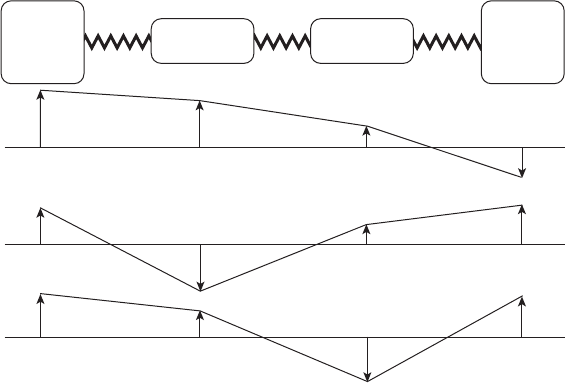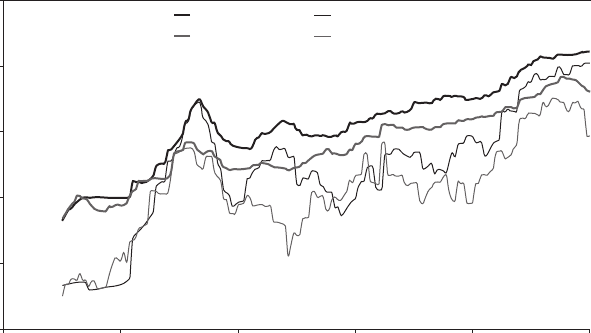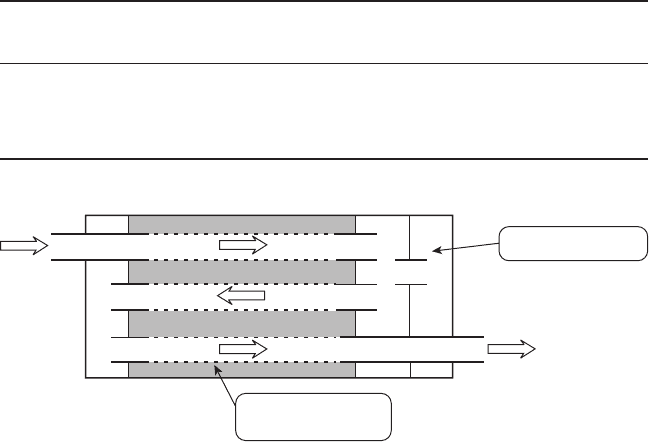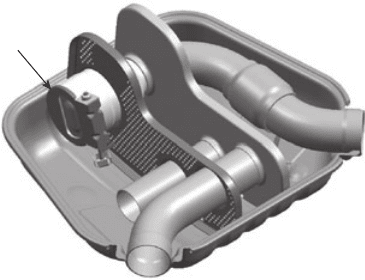Wang X. Vehicle Noise and Vibration Refinement
Подождите немного. Документ загружается.


Noise and vibration refi nement of powertrain systems in vehicles 275
© Woodhead Publishing Limited, 2010
The fi rst torsional elastic mode of the driveline system is referred to as
the driveline surge mode. The surge mode is felt as a longitudinal surge or
jerk by the driver as he rapidly steps on or off the throttle pedal and the
engine produces a rapid change in torque. This broadband excitation pro-
vides the source input to excite the low frequency mode. Figure 12.8 shows
that the torsional stiffness of the driveline and the inertia of the vehicle are
the controlling parameters of the mode. In a manual transmission, it is very
diffi cult to dampen this mode, and the mode is usually avoided by tuning
the engine calibration to reduce the rate of torque change when com-
manded by a throttle input from the driver. The driveline surge mode can
cause audible clunks in the driveline system at locations where there is
mechanical lash. An example is from the clashing of gear teeth in the trans-
mission or differential. In the case of an automatic transmission, this mode
is reduced by the isolation provided by an unlocked torque converter.
The second torsional mode of the driveline is often associated with gear
rattle in manual transmissions. This is because the gear sets are at the loca-
tion of an anti-node or maximum torsional velocity. The torsional velocity
fl uctuations in the gears cause clashing of the gear teeth that creates a rat-
tling noise. Refer back to the discussion in Section 12.4.3 on methods used
to control gear rattle.
Higher torsional modes of the driveline can amplify whine from the fi nal
drive gear set. In this case, high frequency vibrations from the tooth meshing
can excite this mode and amplify gear whine. The mass of the differential
Engine
interia
First mode
Driveline surge
Second mode
Gear rattle
Third mode
Differential
Transmission
interia
Clutch
stiffness
Propshaft
stiffness
Driveshaft
and wheel
stiffness
Final drive
interia
Vehicle
interia
12.8 Driveline torsional mode shapes.
Copyrighted Material downloaded from Woodhead Publishing Online
Delivered by http://woodhead.metapress.com
ETH Zuerich (307-97-768)
Sunday, August 28, 2011 12:07:49 AM
IP Address: 129.132.208.2
276 Vehicle noise and vibration refi nement
© Woodhead Publishing Limited, 2010
crown and pinion gears and the axle shaft stiffness are controlling proper-
ties of the mode.
Apart from torsional modes of the driveline, there are also bending
modes. The fi rst bending mode of the driveline is in the mid-frequency
range and can be excited by reciprocating or rotating imbalance forces from
the engine. It is often the cause of a booming noise inside the vehicle at a
given engine speed. Refer to the discussion on engine mounting in Section
12.4.1 on placement of the engine mounts at the node points in order to
minimise the transfer path of the noise into the body.
12.4.6 Induction
The induction and exhaust system generate a signifi cant proportion of noise
from the powertrain when the engine is operating under high load. In addi-
tion to managing the resonances or transfer paths that can generate
unwanted noises, the induction noise sound quality can be tuned to give
the car the desired character.
The source of induction noise is the airborne pressure pulses generated
when the engine inlet valves shut. Since this occurs at the same rate as
engine combustion, the induction noise has a primary frequency the same
as the engine fi ring order. Harmonic content depends upon the speed of
the inlet valve closure, and is affected by acoustic tuning or resonances of
the inlet manifold and runners. To achieve a smooth and refi ned character
of induction noise, it is desirable to have a primary order that increases
linearly with engine speed and less contribution from the harmonic orders.
On the other hand, a sporty note requires tuning of the system to achieve
a modulated combination of the harmonic orders.
The induction noise is very dependent upon the position of the throttle
blade valve in a gasoline engine. Induction noise is most prominent when
the throttle valve is open and the engine under high load. When the throttle
valve is nearly closed, it refl ects the pressure pulses back to the engine, and
induction noise is reduced (except for any whistles generated by the high
velocity air fl owing past any sharp edges near the throttle blade). This
makes induction noise very apparent to the driver as he accelerates, and
hence this is key to providing the character that the vehicle portrays.
The induction pressure pulses are radiated as airborne noise at the mouth
of the induction system. The amplitude and frequency content of the noise
emanating from the mouth is a function of the acoustic properties of the
ducts and expansion chambers incorporated into the induction system.
Standing waves, and hence potential boom noises, are dependent upon the
length of the ducting and runners in the system. It has become usual prac-
tice to reduce the standing waves that cause problems by incorporating
reactive resonators. An expansion chamber is incorporated into most
Copyrighted Material downloaded from Woodhead Publishing Online
Delivered by http://woodhead.metapress.com
ETH Zuerich (307-97-768)
Sunday, August 28, 2011 12:07:49 AM
IP Address: 129.132.208.2

Noise and vibration refi nement of powertrain systems in vehicles 277
© Woodhead Publishing Limited, 2010
designs in the guise of the air fi lter box. Although the primary function is
to house the fi lter element, the fi lter box is a large expansion chamber that
assists in broad attenuation of the induction noise. A rule of thumb in
designing the fi lter box is to package a volume of three times the engine
capacity.
Tuned reactive resonators such as quarter-wave or Helmholtz resonators
are also commonly employed to attenuate noise at specifi c frequencies that
may cause excessive interior or exterior noise. They are incorporated as
branches connected to the induction ducts.
Airborne noise can also be radiated from walls of the induction system
components. The fi lter box is generally the most susceptible due to its large
and fl at thin walls. By incorporating ribbing, the fi lter box walls should be
designed so that the panel modes are above the primary excitation fre-
quency of the induction system. Likewise, induction and engine noise can
be readily radiated from the inlet manifold system, since this also usually
incorporates large fl at surfaces.
The fi lter box and ducting should be isolated from the vehicle body to
ensure that there are no structure-borne paths of the system into the vehicle
body.
Figure 12.9 provides an example of the contribution of the induction
system noise inside the vehicle during a wide-open-throttle run-up. A
common experimental technique is to fi t an additional large muffl er to the
induction system in order to silence it, and repeat the run-up measure-
ments. The result in Fig. 12.9 clearly demonstrates that the peaks in noise
1000 2000
Baseline - OA Baseline - 3rd order
Remoted - OA Remoted - 3rd order
90
80
70
60
50
40
Interior sound pressure level (dB(A))
3000 4000
Engine speed (rpm)
5000 6000
12.9 V6 induction noise measured during a full-load run-up and
compared with the induction system silenced.
Copyrighted Material downloaded from Woodhead Publishing Online
Delivered by http://woodhead.metapress.com
ETH Zuerich (307-97-768)
Sunday, August 28, 2011 12:07:49 AM
IP Address: 129.132.208.2
278 Vehicle noise and vibration refi nement
© Woodhead Publishing Limited, 2010
levels at 2500 rpm and 3200 rpm are associated with noise from the
vehicle’s induction system.
12.4.7 Exhaust
The level and character of the noise from the exhaust system has a signifi -
cant effect on the perceived powertrain refi nement of the vehicle. As such,
a set of well-defi ned targets is usually established very early in the develop-
ment of a new vehicle.
The contributors to exhaust sound quality are:
• Low frequency vibration modes of the exhaust system creating
structure-borne booms
• Mid-frequency airborne noise from the tailpipe
• Mid-frequency airborne noise radiated from the muffl er shells and pipes
• High frequency rush/hiss of the exhaust gas exiting the tailpipe.
In addition to meeting the above sound quality objectives, the exhaust
system design must meet government exterior noise regulations and oppos-
ing powertrain performance requirements.
Tailpipe noise is generated from the exhaust gas pulses leaving the
engine. The primary frequency is at the fi ring frequency of the engine and
it also contains harmonics. Where pipe lengths may be uneven between
cylinder banks, or uneven fi ring occurs, half-orders can also be generated.
The crudest method to reduce tailpipe noise is to put a restriction in the
exhaust system, but this signifi cantly affects back-pressure and leads to an
unacceptable loss of engine power. As a rule of thumb, a 5 kPa increase in
back-pressure can result in a 1% loss in engine peak power. Thus a series
of reactive and absorptive muffl er elements are used to control exhaust
tailpipe noise.
Reactive muffl ers are designed with the principle of using refl ection to
change the phase of waves and resultant attenuation due to phase
cancellation. Reactive muffl ers consist of combinations of reactive tuning
elements, including expansion chambers, quarter-wave resonators and
Helmholtz resonators. It is important that a reactive muffl er be positioned
at an anti-node point in order for it to function optimally. Table 12.7 pro-
vides a guide for the total muffl er volume required to reduce exhaust noise
to an acceptable level.
Resistive muffl ers make use of absorption to reduce noise. Thus resistive
muffl ers are useful for reducing broadband noise, and are more effective
at reducing high frequency noise compared to reactive muffl ers. They can
generally be located in any position in the exhaust system because the
absorption process is relatively independent of phase. Typical porous mate-
rials used in muffl ers include fi breglass roving or stainless steel mesh. A
Copyrighted Material downloaded from Woodhead Publishing Online
Delivered by http://woodhead.metapress.com
ETH Zuerich (307-97-768)
Sunday, August 28, 2011 12:07:49 AM
IP Address: 129.132.208.2

Noise and vibration refi nement of powertrain systems in vehicles 279
© Woodhead Publishing Limited, 2010
higher density of absorber means better acoustic performance; however,
this comes at a cost of increased weight and cost.
A tri-fl ow muffl er is typical of a muffl er used on passenger vehicles (see
Fig. 12.10). It is a combination of perforated tubes and chambers separated
by baffl es to dissipate and refl ect the sound waves. It can contain all of the
above methods to reduce noise in a single package.
Flow noise in exhaust systems is generated by turbulence in the high
velocity gas fl ow. The noise is broadband in character, and is typically
centred from 1 to 3 kHz. To avoid this problem, use a large diameter pipe
to reduce gas velocity, and avoid sharp edges and bends to minimise fl ow
disturbances.
Exhaust noise can be radiated from the walls of pipes and muffl ers due
to the high sound pressure levels in the exhaust gas. Pressed muffl er shells
that have ribbing to provide stiff surfaces are commonly used. Muffl ers and
exhaust pipes incorporating laminated layers are also commonly used in
minimising radiated noise.
Since the exhaust system is constructed from long lengths of steel pipe
with lumped masses attached (muffl ers), bending modes of the exhaust
system may cause severe problems because the long steel pipes act as
springs with very little damping. These modes are in the low to mid-
frequency range, and as chance has it, a mode will often be precariously
Expansion chamber
filled with roving
Helmholtz chamber
12.10 Tri-fl ow muffl er layout.
Table 12.7 Estimate for total muffl er volume
Vehicle class Four-cylinder
engine
Six-cylinder engine Eight-cylinder
engine
Sporty car Four times engine
displacement
Three times engine
displacement
Three times engine
displacement
Quiet car Ten times engine
displacement
Seven times engine
displacement
Six times engine
displacement
Copyrighted Material downloaded from Woodhead Publishing Online
Delivered by http://woodhead.metapress.com
ETH Zuerich (307-97-768)
Sunday, August 28, 2011 12:07:49 AM
IP Address: 129.132.208.2
280 Vehicle noise and vibration refi nement
© Woodhead Publishing Limited, 2010
placed near the idle speed of the engine, causing an excessive level of boom
and vibration. The most important action to minimise the transfer path of
exhaust vibration is to ensure adequate isolation of the exhaust system from
the body. The exhaust hanger brackets must be stiff and mounted to the
body on an isolated frame or stiff section, and the rubber hangers should
be as soft as possible to ensure good isolation.
Other countermeasures to minimise exhaust vibration include optimising
the exhaust pipe stiffness (i.e., wall thickness or diameter, or bracing) to
avoid bending modes near engine idle and cruising speeds. Flexible cou-
plings are useful in isolating the exhaust system from the engine, as well as
providing relative movement between exhaust and engine.
12.5 Future trends
12.5.1 Sound quality
To better differentiate a brand of motor car from its competitors, in the
future vehicle manufacturers are more likely to make more use of sound
quality engineering to produce a unique brand character. This section
reviews new hardware designed to give manufacturers the tools they need
to deliver a unique brand sound.
Future trends will affect the sophistication of exhaust systems and the
sound quality requirements placed on them, and active exhaust tuning
systems are becoming an important enabler for meeting sound quality
objectives. An active exhaust system refers to a switch in exhaust tuning
under driving conditions. A switchable exhaust can have one tuning for low
engine speed or low load, and another tuning for high speed or high load,
allowing for a reduction in back-pressure to reach engine performance
targets (Hill 2002).
Typically referred to as a semi-active system, a spring-loaded fl apper
valve is a means of implementing switchable exhaust tuning. The valves are
normally placed in the exhaust path inside a muffl er. Under low load condi-
tions, the valve remains shut and exhaust gas is routed through a path that
provides maximum noise attenuation. As engine load and speed increase,
the gas fl ow opens the valve, providing an alternative path for the exhaust
gas and resulting in less noise attenuation and back-pressure. These semi-
active valves are ideally suited to solving exhaust noise problems at low
loads, such as idle boom or cruising exhaust boom.
Figure 12.11 shows an example of a semi-active valve in the left rear
muffl er of a passenger vehicle. In this case, the vehicle had a dual exhaust
system with twin rear muffl ers but suffered from an exhaust boom at idle.
The incorporation of the valve in one of the muffl ers increased back-
pressure and considerably reduced the boom at idle. At higher engine
Copyrighted Material downloaded from Woodhead Publishing Online
Delivered by http://woodhead.metapress.com
ETH Zuerich (307-97-768)
Sunday, August 28, 2011 12:07:49 AM
IP Address: 129.132.208.2

Noise and vibration refi nement of powertrain systems in vehicles 281
© Woodhead Publishing Limited, 2010
speeds, the light spring loading enabled the valve to open, and the exhaust
functioned normally as a low back-pressure system and generated a pur-
poseful exhaust note.
An active system is used to refer to an exhaust valve that can be com-
manded open or shut by the engine controller. This fl exible control allows
the point of exhaust tuning switchover to be precisely controlled, providing
optimal noise performance as well as optimal engine performance. However,
the drawback is the expense of these systems. Vacuum-operated valves are
more reliable than electric valves due to the heat in the exhaust system,
and this drives the added complexity of vacuum valves, lines and reservoirs
to service the actuator.
Induction noise is an equally important key to providing a specifi c sound
character. There is increasing use of turbochargers in sports cars, but a
turbocharged system naturally has a quieter induction note than a normally
aspirated engine. One approach to bring the excitement of induction noise
back to a turbocharged engine is to utilise devices to enhance the induction
noise. A device currently appearing on the market consists of a side branch
in the induction system that terminates with a soft membrane. By tuning
the length of the side branch and the stiffness properties of the membrane,
a pleasing induction noise can be generated. In order to minimise exterior
pass-by noise, the outlet from the membrane can be ducted directly into
the cabin so that the induction noise is apparent to the occupants. A similar
device has also been proposed to enhance exhaust noise (Wolf et al. 2003).
Lower costs of electronics and microprocessors will also have a role to
play in tailoring vehicle noise and vibration character, despite limited appli-
cations at the moment. Active noise control (ANC) and active vibration
control (AVC) can be considered as the epitome in tuned vibration absorber
evolution.
Flapper valve
12.11 Muffl er cutaway revealing a semi-active exhaust valve.
Copyrighted Material downloaded from Woodhead Publishing Online
Delivered by http://woodhead.metapress.com
ETH Zuerich (307-97-768)
Sunday, August 28, 2011 12:07:49 AM
IP Address: 129.132.208.2
282 Vehicle noise and vibration refi nement
© Woodhead Publishing Limited, 2010
The principle of an active control device is to produce a force or pressure
out of phase with that from the powertrain to provide phase cancellation.
Where the excitation is a structure-borne vibration, such as engine noise
through the mounts, it makes sense to use a method of AVC. However,
AVC may never become viable in the automotive market because the cost
and mass of actuators to generate an opposing force can be high. One varia-
tion is to use a resonant spring–mass system to provide a high force output.
For example, this method has been used inside engine mounts to generate
a high opposing force, but has the limitation of providing a suffi cient output
only over a narrow frequency range (Lee and Rahbar 2005). The existing
technology of switchable damping in hydraulic mounts will probably take
the position as the preferred method of isolating the engine from the body.
ANC has its problems as well. Due to the spatial dependence of noise in
the cabin, often an array of microphones and speakers are required to
effectively provide noise cancellation at all seating locations. Thus the
higher the frequency of noise to be cancelled, the higher the cost of elec-
tronic hardware and the complexity of the software. One proposal to over-
come this problem is to cancel the noise at its source, for example by placing
the feedback speaker inside the exhaust system (Garabedian and Zintel
2001) or induction system (Vaishya 2005).
12.5.2 Fuel economy challenges
Ultimately the greatest challenge in the future will be maintaining good
noise and vibration refi nement while meeting ever-tightening fuel economy
requirements of the vehicle. The challenges driven by fuel economy can be
categorised as a ‘triple-whammy’ for noise and vibration engineers:
• Greater source excitation from internal combustion engines
• Vehicle mass reductions
• Engineering budget biased towards fuel economy improvements.
New and higher vibration sources can be expected in the evolution of the
internal combustion engine and driveline. Already we are seeing early
lockup of the torque converter on automatic transmissions (Hage and
Szatkowski 2007). Even if electronic slip control is used to maintain tor-
sional isolation from the engine, the result is engine speeds at highway
cruise extending down to lower speeds than before. Designing for cruising
refi nement means that all vibration modes in the extended cruise window
of operation must be controlled.
New engines will also bring higher loads and forces to contend with.
Diesel engines, although not exactly new, provide a good example. Higher
torque levels from diesel engines generate larger torque pulses that result
in many driveline vibration challenges. Diesel engines also present a
problem of high-frequency airborne noise levels from their high-pressure
Copyrighted Material downloaded from Woodhead Publishing Online
Delivered by http://woodhead.metapress.com
ETH Zuerich (307-97-768)
Sunday, August 28, 2011 12:07:49 AM
IP Address: 129.132.208.2

Noise and vibration refi nement of powertrain systems in vehicles 283
© Woodhead Publishing Limited, 2010
fuel injection noises and high rate of compression combustion noise (Wang
et al. 2007). Gasoline engines also are evolving towards characteristics of
diesel engines. Already on the market are direct injection gasoline engines,
which have the characteristic high-pressure fuel delivery ticking noises of
a diesel. In the future, gasoline engines are expected to further evolve to
take on diesel-like compression ignition modes of operation under cruising
conditions.
Table 12.8 lists a number of engine technologies that are being
phased into production by the world’s vehicle manufacturers in response
to improving fuel economy. Each of these presents new forces and vibration
sources that must be designed for.
Table 12.8 New engine technologies
Engine technology Noise and vibration
challenges
Noise and vibration enablers
Early torque
converter
lockup
Loss of driveline torsional
vibration isolation at low
speed
Driveline tuned vibration
damper
Separation of system modes
Low idle speed Poor isolation of engine
mounting system
Soft or switchable/active
engine mounts
Exhaust resonances Separation of system modes
from idle speed
Shake due to poor
combustion stability of
engine
Hydraulically damped
engine mounts
Engine shut-off at
idle
Shake on start-up Hydraulically damped
engine mounts
Noisy electrically driven
accessories
Variable-speed accessories
Diesel engine High combustion noise
and rattle
Additional vehicle insulation
package and controlled
fuel injection
Idle vibration/boom Soft or switchable/active
engine mounts
Driveline vibration/boom Driveline tuned vibration
damper
Direct injection
gasoline engine
Fuel system ticking noises Additional vehicle insulation
package
Turbo-charging Turbo whine Induction system resonators
Higher combustion noise Additional vehicle insulation
package
Cylinder
deactivation
High driveline torsional
vibration
Driveline tuned vibration
damper
Loss of engine mounting
isolation
Soft or switchable engine
mounts
Exhaust booms Exhaust acoustic and
structural tuning
Copyrighted Material downloaded from Woodhead Publishing Online
Delivered by http://woodhead.metapress.com
ETH Zuerich (307-97-768)
Sunday, August 28, 2011 12:07:49 AM
IP Address: 129.132.208.2
284 Vehicle noise and vibration refi nement
© Woodhead Publishing Limited, 2010
If you are dealing with a noise and vibration problem caused by one of
the above engine technologies, you probably have plans to add counter-
measures. But these add mass, and extra mass has now become an unmen-
tionable word in the automotive world. Even if you do get to add mass, you
will probably need to do a deal with your engineering manager to balance
it by taking mass out elsewhere. And every little piece of the car will repeat-
edly go under the microscope for any opportunities for mass reduction.
What this potentially means is less stiff components and fewer add-on
vibration absorbers. Make sure you have done your homework, and can
argue your case to maintain subsystem targets.
Last but not least come considerations of cost. The priority of spending
will be meeting the fuel economy targets of the vehicle program. Whether
that includes fi xing the noise and vibration problems it causes will vary from
program to program. You will need to prove that you have optimised your
solutions with regard to cost and mass, and this is where mathematical
analysis models help to gain a better understanding and optimised solutions
to noise and vibration refi nement.
12.6 Conclusions
Integration and sound quality engineering of the powertrain is a critical
factor in meeting customer expectations due to the inevitable link between
vehicle noise and the perception of quality. This chapter has described the
process for integrating the powertrain into passenger vehicles. The fi rst step
in the process is to set targets for the vibration source levels and isolation
of paths. The second step is to make use of enablers to tailor the induction
and exhaust character to meet the customer’s expectation of the vehicle.
In summary, a good powertrain noise and vibration engineer will apply
the following practices:
• Set targets prior to development.
• Thoroughly validate the vehicle under all operating conditions and
measure against the targets.
• Use a methodical approach to solve the problem. For example, consider
the role of the source, path and receiver.
• Consider and balance aspects of the solution. For example, determine
trade-offs between noise performance, cost, mass and manufacturing
impact.
12.7 References
Bosch (1986), Automotive Handbook, 2nd edition, Stuttgart, Robert Bosch
GmbH
Copyrighted Material downloaded from Woodhead Publishing Online
Delivered by http://woodhead.metapress.com
ETH Zuerich (307-97-768)
Sunday, August 28, 2011 12:07:49 AM
IP Address: 129.132.208.2
